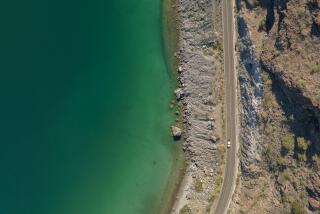From here to eternity: the grunion put on their own show
- Share via
We’ve seen this sort of courtship before. Boy meets girl. Boy loses girl. Girl, now pregnant, buries her tush in the damp and gamey sand to lay her eggs.
Love. Does it get any better than this? I mean really.
If you’ve never seen a grunion run — yes, grunion are fish, not prairie chickens or close cousins of the snipe — I am here to tell you that we can all learn a little something from their steamy beach shenanigans. Forget the birds and the bees. I give you the mighty grunion, sans clothes and any sense of decency — the Lindsay Lohans of the great outdoors.
See, like many Californians, grunion just cannot resist a little canoodling in the sand. The females wiggle up out of the water. The males, as males are prone to do, can’t help but follow. One thing leads to another. A flirty smile. A warm embrace. It’s over in a matter of minutes. But the memories, they can last a lifetime.
Really, the grunion are so much better at this than we’ll ever be. How masterful? They do it all without a drop of tequila.
And they are our story — a consummate California story. The fish, silvery as new dimes, normally run from Southern California north to Santa Barbara. Except for stretches of Baja California, grunion are found nowhere else in the world.
Each spring it happens — triggered by a glorious martini of high tides, moon phases and a sense of romance and survival no one quite understands.
“One of the things we’re really not sure of is how many grunion there are,” says Pepperdine professor Karen Martin, one of the leading experts on the fish. “We don’t know if they’re going up in numbers, or going down.”
Now, I’m of a mind that there are certain things all Californians must do. They should play a trifecta at least once at Santa Anita. They should catch a Rose Bowl on a postcard-perfect New Year’s Day.
They should spend long sultry evenings with the Dodgers or the Angels, and once — maybe only once — try their luck aboard a longboard.
Into this crazy decathlon of California treasures, let’s throw in a grunion run, under a full moon, the waves licking at your ankles. Admission: free.
“It is so spectacular and really beautiful,” says Martin, who has studied the fish for 14 years. “I never get tired of it.”
The grunion have it going on right now, at high tide during full and new moons, at Leo Carrillo, Venice, Belmont Shore, Seal. A bunch of groupies called Grunion Greeters, 500-plus strong, help to monitor their appearances and egg production. The heaviest runs are from April through June. But they appear as late as September.
The other night, just south of Newport, at the Crystal Cove cottages we all love but can never seem to get into, thousands of the 5-inch-long fish showed up, surfing in on the swells, watusi-ing up the beach, then shimmying back out again.
Martin was there with a couple assistants, including Mike Murrie, a Pepperdine journalism professor attempting to catch the activities on tape.
At first, it appeared like a beachy version of “The Blair Witch Project,” five of us stumbling around in the dark at nearly midnight with a night vision scope. Though their appearances are usually timed to the moon, the grunion don’t always show. Tonight, a heron flies by — a natural predator, a telling sign. But by 11:15 p.m., five minutes after their predicted arrival, we’ve seen almost nothing.
Then a wave washes up, leaving dozens scattered along the sand. Show time.
Martin explains that the grunion can stay in the sand for 15 to 20 minutes because, like sea lions or seals, they are able to slow their metabolism to use less oxygen. Runs like this may be brief or last more than an hour. They are always at night (for schedules, go to https://www.grunion.org).
Sometimes, the fish are chased by predators such as sharks or even the occasional skunk working the surf line. They are easy pickings, and their worst enemies are often human. In fact, beginning this month, the grunion are open to anglers who are allowed to catch them only with bare hands, though Martin cautions against such activities.
“When you think of all the people in L.A., and the number of grunions, it’s not a fair fight,” she says.
Martin also is an advocate of beach protections — overgrooming is one cause for concern — for the fertilized eggs remain in the sand till they are washed out of the sand by the next semilunar high tide, 10 days to two weeks later.
It’s past midnight now, and up and down the beach our little posse goes, the water warmer than you might expect, the sea breezes mild even at the late hour. The grunion are showing up in droves now, like a silver rug the ocean lays out, then the ocean takes away.
Yep, it’s showtime, for the mighty grunion, as endemic to our beaches as belly fat and tough leathery feet.
Marvel while you can.



